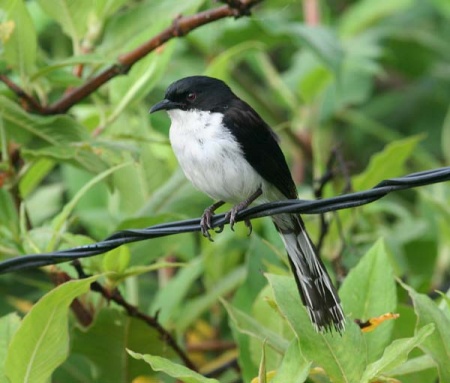(Video link. Obi link deleted. Reference updated) |
(GSearch amended to allow for both scientific names) |
||
| Line 31: | Line 31: | ||
{{ref}} | {{ref}} | ||
==External Links== | ==External Links== | ||
| − | {{GSearch| | + | {{GSearch|Sibia+melanoleuc}} |
<br /> | <br /> | ||
This link searches for videos titled Dark-backed Sibia | This link searches for videos titled Dark-backed Sibia | ||
Revision as of 10:44, 24 March 2017
Alternative names: Black-capped Sibia; Dark-backed Sibia
- Heterophasia melanoleuca
Identification
With 21 -23cm a slender, narrow-billed and long-tailed Babbler:
- Dark brown above
- Black head
- White below
Some subspecies (which are placed in Black-headed Sibia by some authorities) have grey to greyish-brown upper mantle.
Distribution
Found in the mountains of Myanmar, NW and W Thailand and NW Laos. Depending on the taxonomic boundary with Black-headed Sibia, also found in S Laos and Vietnam.
Generally common in its range.1
Taxonomy
This species was long time considered to be conspecific with Black-headed Sibia.
Two to three subspecies recognized:
- H. m. melanoleuca in Southern Myanmar and Western Thailand1,2
- H. m. castanoptera in South-eastern Myanmar1,2
- H. m. radcliffei in Myanmar, North-western Thailand and North-western Laos1
This species is also placed in the genus Malacias and the scientific name spelled Malacias melanoleucus.
Habitat
Broadleaf evergreen forest between 1000m and 2565m.1
Behaviour
Diet
Feeds on insects, grubs, berries and also nectar. Arboreal, usually in the treetops.
Mostly seen in pairs or small groups.
Breeding
Breeding season from February to June. The nest is a cup made of moss, pine needles, grasses and leaves. It's placed on small outer branches of a tree, 2.5 to 7.5 m above the ground. Lays 1 - 3 eggs.
Resident species.1
References
- Del Hoyo, J, A Elliott, and D Christie, eds. 2007. Handbook of the Birds of the World. Volume 12: Picathartes to Tits and Chickadees. Barcelona: Lynx Edicions. ISBN 978-8496553422
- Clements, JF. 2011. The Clements Checklist of Birds of the World. 6th ed., with updates to August 2011. Ithaca: Cornell Univ. Press. ISBN 978-0801445019. Spreadsheet available at http://www.birds.cornell.edu/clementschecklist/downloadable-clements-checklist
Recommended Citation
- BirdForum Opus contributors. (2025) Black-backed Sibia. In: BirdForum, the forum for wild birds and birding. Retrieved 5 January 2025 from https://www.birdforum.net/opus/Black-backed_Sibia
External Links
This link searches for videos titled Dark-backed Sibia




